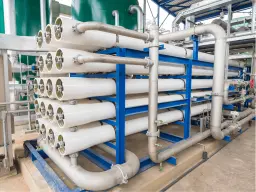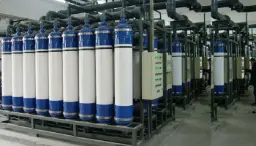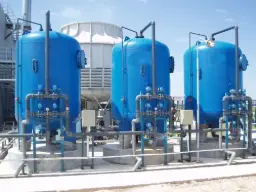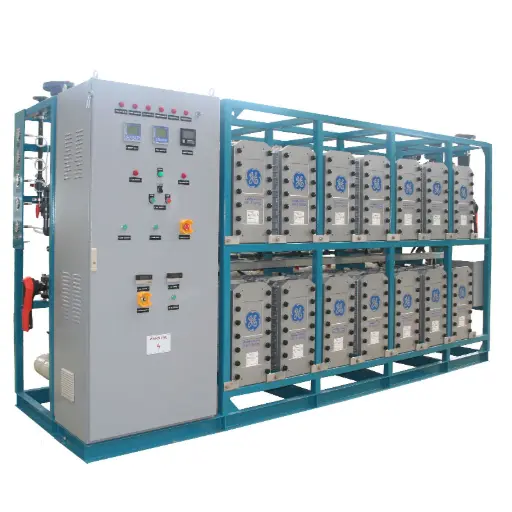Bioreactor Feed Water Treatment
Bioreactors lie at the heart of modern pharmaceutical and biotechnology manufacturing, housing delicate microbial or mammalian cell cultures that synthesize high-value therapeutics, vaccines, and diagnostics. The aqueous medium that feeds these reactors must meet far tighter specifications than ordinary process water because even trace levels of ionic impurities, endotoxins, or particulates can throttle cell growth, skew product glycosylation patterns, or provoke costly batch failures. Bioreactor feed water, therefore, is a rigorously treated and monitored utility stream, typically produced through a multibarrier train that combines softening, reverse osmosis (RO), electrodeionization (EDI), ultraviolet (UV) organic reduction, and sub-micron filtration. In United States Pharmacopeia terminology, the finished water quality aligns with “Purified Water” or, for upstream perfusion processes requiring injectable-grade sterility, “Water for Injection” (WFI). Whichever specification applies, the water must remain microbiologically stable under ambient or hot-loop distribution, maintain conductivity often below 1.3 µS cm⁻¹ at 25 °C, and exhibit total organic carbon (TOC) values well under 500 ppb.
Within a GMP facility the bioreactor feed system forms a closed, validated loop from pretreatment skids all the way to the point-of-use diaphragm valve at the bioreactor head plate. Continuous recirculation at turbulent velocity, periodic hot-water or ozonated sanitisation, and redundant 0.2 µm point-of-use filters guard against biofilm formation that could otherwise shed endotoxins into the culture medium. Control logic integrates inline sensors for conductivity, TOC, ozone residual, temperature, and differential pressure, feeding data to the site’s 21 CFR Part 11-compliant SCADA historian. In recent years manufacturers have layered on machine-learning algorithms that detect subtle drift in RO differential pressure or EDI voltage—early warnings that membrane fouling or resin exhaustion is starting. Taken together, these engineering and digital safeguards ensure that every litre of make-up water entering the bioreactor nurtures cells rather than introducing stress, thereby maximising viable cell density, product titre, and ultimately batch profitability.
Water Treatment Systems Used for Bioreactor Feed Water
Before detailing the individual unit operations, it is worth framing why such an elaborate treatment train is needed in pharmaceutical and biotech environments. Raw municipal feed may already meet potable standards, yet regulatory authorities such as the FDA, EMA, and WHO demand water of far higher purity when it contacts active pharmaceutical ingredients. Ionic strength must be so low that charge interactions in the culture medium remain governed by deliberate nutrient formulations, not by stray sodium or chloride. Organic trace contaminants—whether humic substances or industrial herbicides—can act as cytotoxins at parts-per-billion levels. Even dormant bacterial fragments known as endotoxins trigger an inflammatory cascade in mammalian cells, jeopardising product safety. Consequently, the following technologies are deployed in a carefully sequenced manner to strip away each impurity class while preserving flow, pressure, and energy efficiency:

Reverse Osmosis
Provides a 1st-pass barrier that rejects ≥ 98 % of dissolved ions, endotoxins, and low-molecular organic compounds while operating at 15-20 bar.

Ultrafiltration
Ensures a sterile barrier by removing colloids and bacteria larger than 0.01 µm and withstands 85-°C sanitisation cycles without polymer degradation.

Activated Carbon Filter
Adsorbs chlorine or chloramine disinfectants that would otherwise damage downstream RO membranes.

Electrodeionization (EDI)
Polishes RO permeate to resistivity > 15 MΩ-cm by electromigrating residual ions through mixed-bed ion-exchange resins, eliminating the need for caustic-acid regeneration.
These systems are critical in pharmaceutical and biotechnology facilities because each tackles an impurity class that can cripple cell culture performance or violate pharmacopeial monographs. RO addresses bulk ionic and organic load, EDI refines conductivity to ultrapure levels, and UF provides microbiological insurance. The activated carbon beds protect membrane integrity by neutralising oxidants, while the electropolished loop preserves purity right to the bioreactor flange. Collectively they create a layered defence that satisfies both regulators and process scientists striving for reproducible, high-yield bioprocesses.
Key Water-Quality Parameters Monitored
Meeting bioreactor feed specifications is not a one-time achievement but a live, data-driven discipline. Engineers must watch an ensemble of chemical, physical, and microbiological indices, correlating them with cell growth curves and deviation logs. Conductivity serves as a rapid proxy for total ionic load, yet alone it cannot unveil carbonyl-bearing organics that may slip through RO; therefore inline TOC analyzers oxidise organic molecules to CO₂ and quantify the resultant conductivity spike. Microbial counts, traditionally obtained by plate culture, now employ rapid ATP bioluminescence assays that deliver trendable results in minutes rather than days, supporting real-time release testing. Endotoxin monitoring likewise evolves from Limulus Amebocyte Lysate (LAL) to recombinant Factor C fluorescence methods, eliminating variability linked to horseshoe crab lysate batches.
Temperature, flow, and ozonation residual round out the critical parameters, each with direct influence on biofilm control and sensor accuracy. A drop in return-loop temperature below 70 °C during hot-water sanitisation could leave thermotolerant spores alive. An undersized pump that cannot maintain turbulent velocity invites laminar niches where Pseudomonas species anchor. Likewise, ozone concentration must exceed 0.02 ppm to disinfect crevices yet vent safely at the degassing column to avoid oxidative stress on downstream filters. Digital twins of the water room now simulate these parameters, guiding predictive interventions and minimising downtime.
| Parameter | Typical Range | Control Method |
|---|---|---|
| Conductivity | ≤ 1.3 µS cm⁻¹ (Purified Water), ≤ 0.25 µS cm⁻¹ (WFI) | Inline conductivity cell with auto-calibration against USP-grade NaCl |
| Total Organic Carbon (TOC) | ≤ 500 ppb | UV persulfate oxidation plus NDIR detection, alarm at 350 ppb |
| Endotoxin | < 0.25 EU mL⁻¹ | Online recombinant Factor C, UV pretreatment, periodic LAL for reference |
| Microbial ATP | < 10 fg mL⁻¹ | Inline bioluminescence probe, hot-water sanitisation cycles |
| Temperature (Sanitisation) | 80 ± 2 °C for ≥ 30 min | Dual RTDs, loop recirculation pump VFD control |
Prior to the subsequent figure, it is helpful to visualise how rapidly RO permeate quality can deteriorate if pretreatment falters. Trends in conductivity against time often reveal membrane fouling weeks before feed pressure alarms.
Design & Implementation Considerations
Each pharmaceutical site starts with a mass-balance of bioreactor make-up rate, buffer preparation needs, and CIP solution volumes to size the RO-EDI skid and buffer tank. Engineers then model worst-case raw water fluctuations using decades of municipal quality data, accommodating low-temperature feed through variable-frequency drives on high-pressure pumps. Material selection defaults to 316L stainless steel with ASME-BPE fittings, orbital welds, and electropolishing to a surface roughness below 0.4 µm Ra, minimising microbial harbours. Where plastics are unavoidable—such as UF housings—polyvinylidene fluoride (PVDF) or polysulfone with documented extractables profiles are mandatory.
Sanitary design extends to double-tube-sheet heat exchangers that separate WFI from glycol circuits, slope-to-drain piping at 2 mm m⁻¹, and diaphragm valves with spring-energised PTFE diaphragms rated for repeated steam exposure. Automation engineers implement redundant PLCs with fail-safe interlocks so that any critical sensor fault triggers loop diversion to drain rather than risking contaminated water reaching production. Digitalisation focuses on ISA-88 batch records, OPC UA data exchange to lab information systems, and plant-wide historian dashboards that display Key Performance Indicators like %RO recovery, EDI cell voltage, and sanitisation compliance. Lastly, sustainability targets push designers toward energy-efficient RO pumps with ERD (Energy Recovery Devices) and heat-recovery loops that reclaim steam-condensate energy for preheating raw feed.
Operation & Maintenance
Running a bioreactor feed utility requires vigilant routine coupled with agile troubleshooting. Operators log hourly checks of differential pressure across multimedia filters, ensuring backwash cycles fire before fines break through and cake RO membranes. Chemical addition—often sodium bisulfite and antiscalant—must follow stoichiometric demand curves calculated from online ORP and Langelier Saturation Index data, avoiding excess that might feed heterotrophs downstream. Weekly CIP of RO trains alternates alkaline and acidic detergents, with eddy-current flow verification to confirm membrane wetting at all spacers.
EDI stacks call for quarterly performance qualification, comparing cell voltage versus product resistivity to detect resin exhaustion or scaling on ion-exchange membranes. Hot-water or ozone sanitisation cycles are scheduled biweekly, yet triggered sooner if online ATP trends climb. During each thermal cycle, validation technicians place calibrated loggers at dead-leg worst-case locations, verifying that F₀ sterilisation value exceeds 121 °C-equivalent minutes. Consumables such as 0.2 µm filters are changed on pressure-based life, not calendar, reducing cost without compromising sterility. Finally, maintenance programmes integrate vibration analysis on high-pressure pumps and infrared thermography on motor bearings, moving towards condition-based rather than time-based overhaul.
Challenges & Solutions
Even the most robust design faces unpredictable raw-water swings, unplanned production surges, and ever-tightening regulatory expectations. Silica breakthrough during spring snowmelt can foul RO membranes and shorten EDI resin life. The solution pairs inline coagulation-filtration with real-time particle counters that trigger coagulant dose adjustments within seconds. Sudden vaccine demand spikes can double bioreactor capacity overnight; modular skid designs with plug-and-play RO racks let plants add 20 m³ h⁻¹ capacity over a single weekend.
Legionella and mycoplasma fears drive authorities to scrutinise distribution loops more aggressively. Installing UV-LED point-of-use lamps directly in valve blocks neutralises pathogens without chemicals or heat, and their digital drivers log dose delivery for audit. Cybersecurity emerges as a subtle but severe challenge; malware on a facility network could spoof conductivity readings and mask contamination. ISA-62443 segmentation, firewalls, and multifactor authentication now sit beside mechanical seals as equally essential barriers. Finally, water scarcity pushes companies to reclaim condensate and clean-in-place (CIP) rinse water via secondary RO-UF loops, reducing incoming municipal demand by up to 40 %, trimming both cost and corporate carbon footprint.
Advantages & Disadvantages
Engineers and quality managers must weigh the tangible benefits of high-specification bioreactor feed water against capital and operational burdens. A feed system that delivers consistent purity improves batch yield, shortens downstream purification, and slashes deviation investigations—translating into faster product release and greater plant throughput. It also future-proofs the facility against evolving pharmacopeial standards, reducing the risk of retrofits. Conversely, such systems demand substantial upfront investment, skilled personnel, and rigorous lifecycle validation, all of which can strain cash flow and internal resources.
Operational energy consumption, particularly for RO high-pressure pumps and hot-water sanitisation heaters, exerts ongoing cost and sustainability pressure. Membrane and resin consumable replacement add further expense, while complex automation platforms introduce cybersecurity and obsolescence challenges. Balancing these factors involves strategic design choices such as energy-recovery devices, modular expansion philosophies, and predictive maintenance analytics that curtail unplanned outage risk.
| Advantages | Disadvantages |
|---|---|
| Enhanced cell growth leads to higher product titre and consistent bioreactor performance | High capital expenditure for RO-EDI-UF skids and stainless distribution loops |
| Reduced batch failures minimise costly product losses and deviation reports | Significant energy usage for high-pressure pumps and thermal sanitisation |
| Compliance with USP, EP, and GMP Annex 1 simplifies regulatory audits | Requires specialised operators and continuous training programmes |
| Digital monitoring enables predictive maintenance and data integrity | Membrane and filter consumables incur recurring operational costs |
| Modular scalability accommodates future capacity increases rapidly | Complex automation heightens cybersecurity and software validation workload |
Frequently Asked Questions
A robust engineering culture encourages open dialogue, yet bioprocess teams often share a common set of queries when adopting or upgrading bioreactor feed water systems. By addressing these questions proactively, project managers accelerate stakeholder buy-in and streamline validation timelines. Moreover, clear answers help procurement executives justify budget requests to finance committees, while maintenance planners gain foresight into spare-parts strategies and staffing requirements. The following FAQ distils recurring discussions heard across greenfield vaccine plants, monoclonal antibody facilities, and cell therapy startups, translating technical nuance into actionable guidance for cross-functional teams.
-
Q: How pure does water need to be for microbial versus mammalian cell culture?
A: Most microbial fermentations run successfully on USP Purified Water, whereas sensitive CHO or HEK cell lines benefit from WFI-grade water to minimise trace metals that catalyse oxidative stress. -
Q: Can we cold-store water to save energy instead of running a hot-loop?
A: Cold loops are feasible if residual ozone or UV-C is maintained continuously, but they demand stricter biofilm surveillance and ATP trending. -
Q: How often should RO membranes be replaced?
A: With disciplined pretreatment and CIP, pharmaceutical RO elements typically last 3-4 years before salt rejection drops below 95 % or differential pressure rises above design limits. -
Q: Is single-pass RO sufficient, or do we need double-pass?
A: Double-pass achieves lower conductivity and endotoxin levels, particularly valuable when source water has high TDS or endotoxin spikes, but increases energy use and capital cost. -
Q: What validation activities are required after a membrane change?
A: Post-replacement qualification includes pressure decay testing, conductivity profiling, and at least three consecutive TOC and endotoxin samples within specification before releasing the system back to production. -
Q: How can we integrate water system data into our manufacturing execution system (MES)?
A: Use OPC UA or MQTT brokers with 21 CFR Part 11-compliant data integrity modules; map conductivity, resistivity, and alarm states as electronic batch record parameters. -
Q: Are there eco-friendly chemicals for CIP?
A: Enzymatic cleaners formulated for proteinaceous fouling reduce caustic demand and lower wastewater neutralisation loads, aligning with corporate sustainability goals.